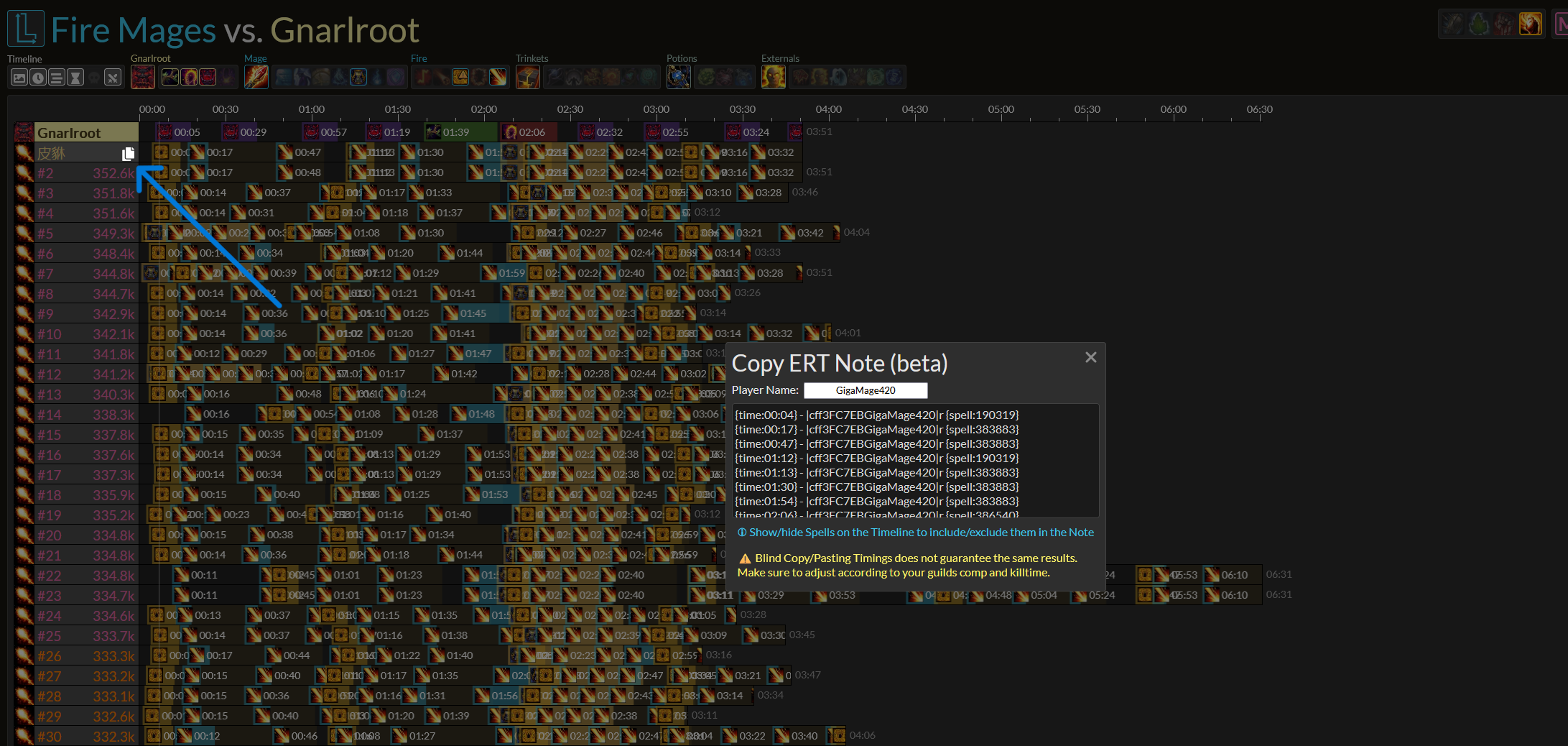Updated as of Apr 6, 2024 / Patch 10.2.6
This is meant to help analyze your play, and is not a rotational guide. Follow the priorities outlined in guides such as Mage Hub, this is meant to serve as a supplement to them. This is also not the end-all-be-all of log reviewing. It is meant to get your feet wet and start identifying common mistakes in your logs. The folks in the Warcraft Logs discord are a great resource for more advance querying.
Logging your play
This article will give you a walkthrough of how to enable and upload logs. Once you've done the required setup, addons such as the Raider.io client, ERT/MRT, and Loggerhead can be configured to automatically log your raids and dungeons.
The Basic Overview
Open your log in Warcraftlogs.
Select the raid fight or dungeon you wish to review.
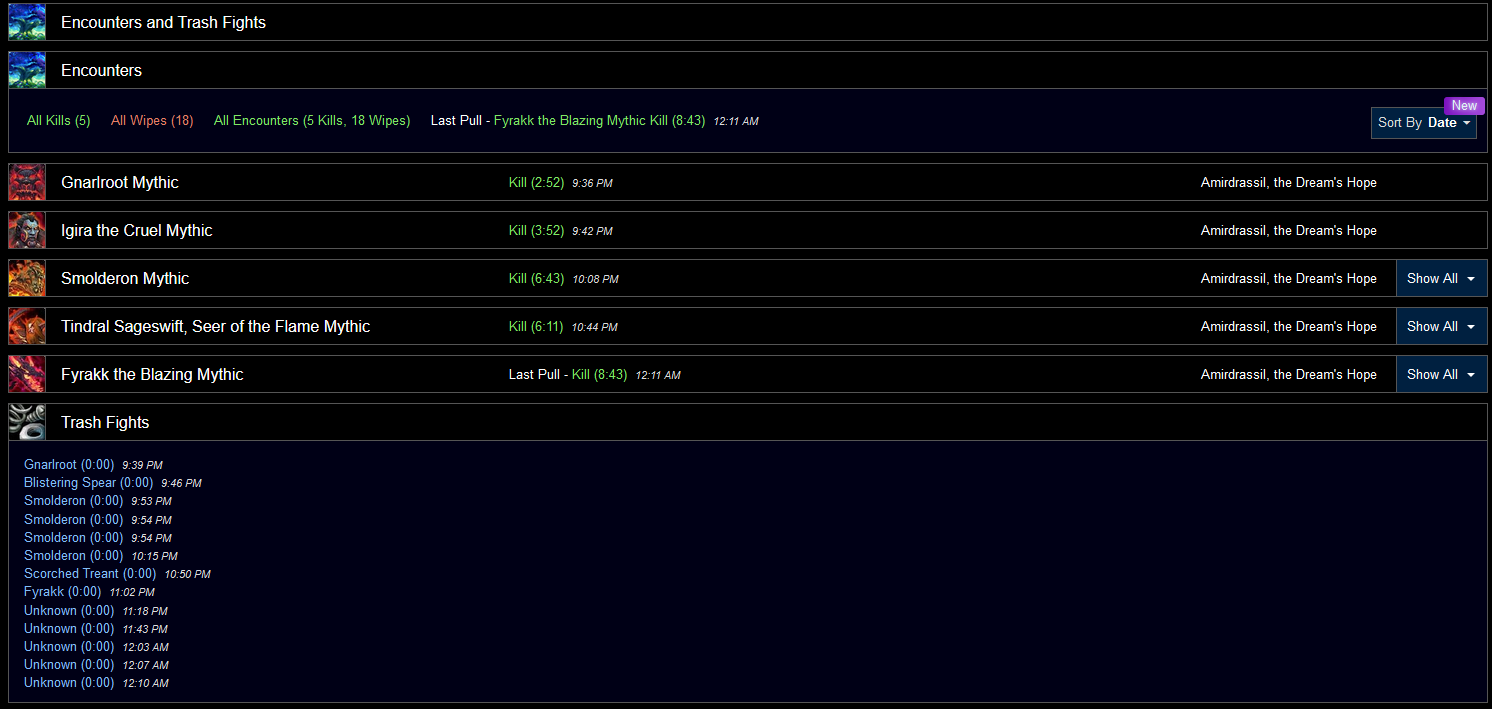
From the initial page, you are going to start by filtering down to your character, and then casts.
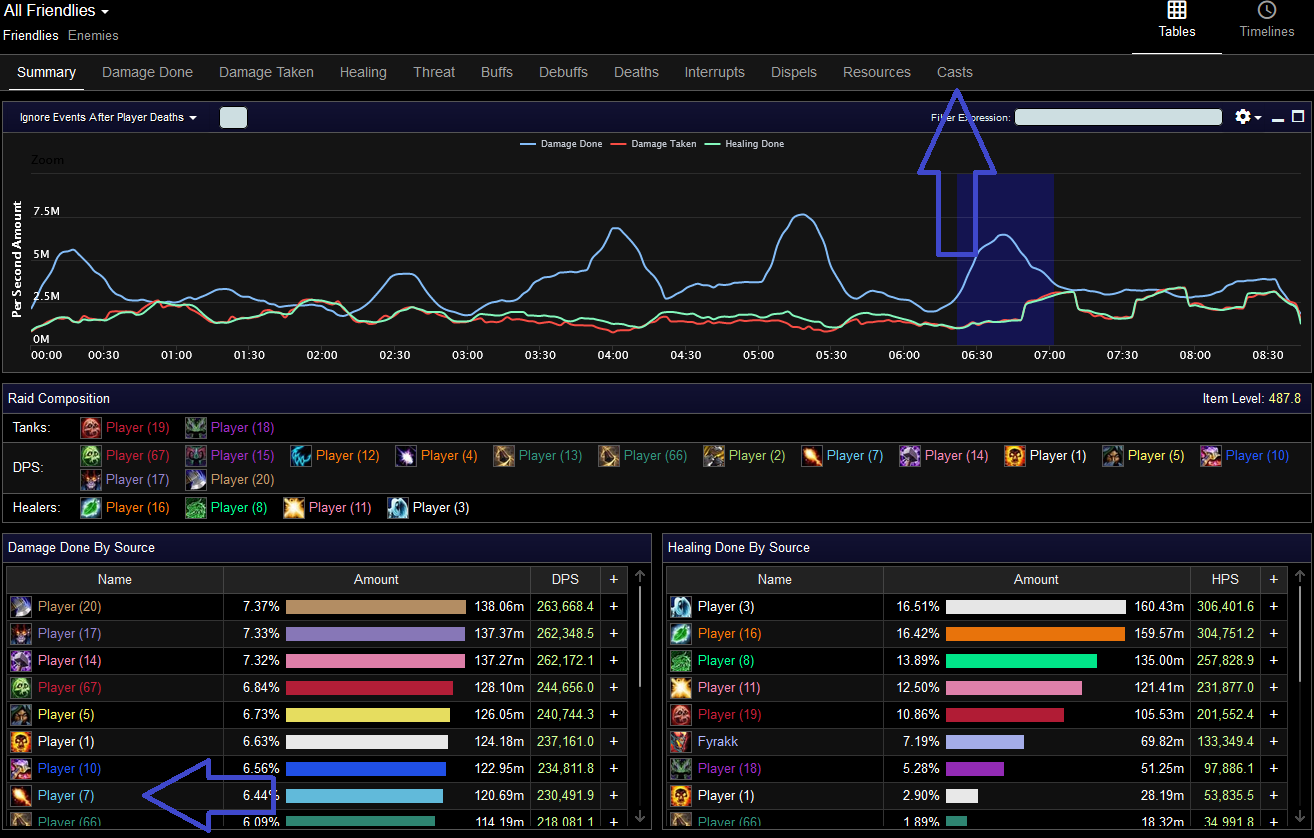 )
)
By default, we are in a table view. This is useful for a generic overview of how often you pressed your buttons. In the top left, you can see the time the dungeon/fight took and with some quick math, a general idea of how
efficent you were with your cooldowns.
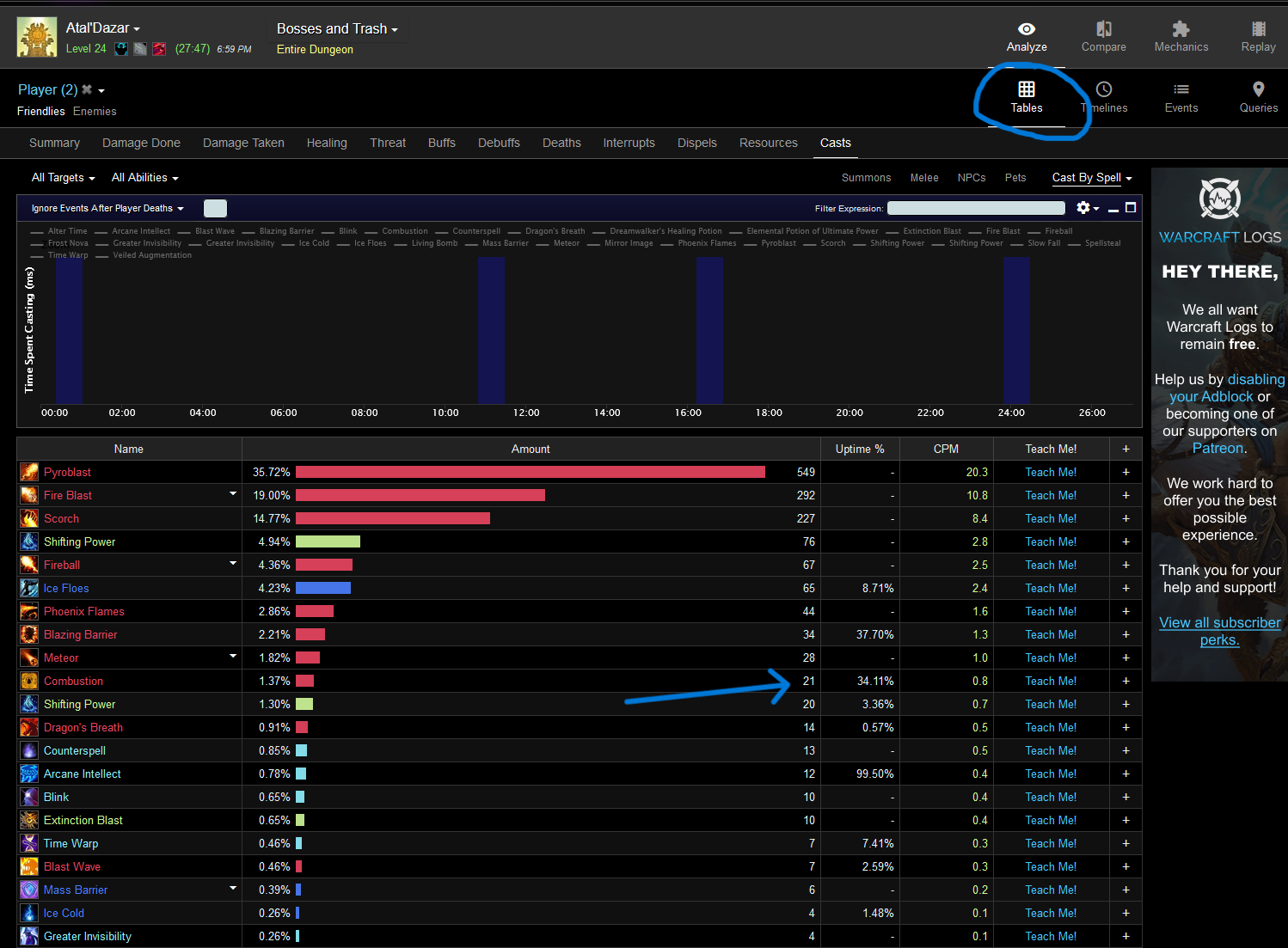 )
)
For example, in this 28 minute Atal, this mage cast Combustion 21 times. When talented into Kindling, Combustion has around a 65-75 second cooldown. This can be effected by hasted effects like double lust, or by intelligent use of Firestarter/Searing touch. This mage likely could have gotten another combust or two in if they were sending it on cooldown and also making more use of Shifting Power, which over the ~28 minute key they only used 20 times.
The common mistakes you can see from this view are things like trinket usage- many new mages tend to sit on their trinket for the 'perfect pull' instead of just sending it when it's up, and Time Warp usages. You should be double lusting as close to on cooldown as possible, with a single lust ~4:30-5m later. Again, sending it when you have it is more important than getting the perfect pull.
To get a more granular view and see our actual rotational mistakes, we swap to the 'Timeline' view.
 )
)
Inside of this view, we can see each cast, timestamped to when it was cast and damaged the target. By default, you'll be seeing the entire dungeon or raid fight in a singular long scrolling bar. You can par this down to specific pulls, bosses, or phases with the menu at the top. Mousing over the ability on the timeline will give you the timestamp.
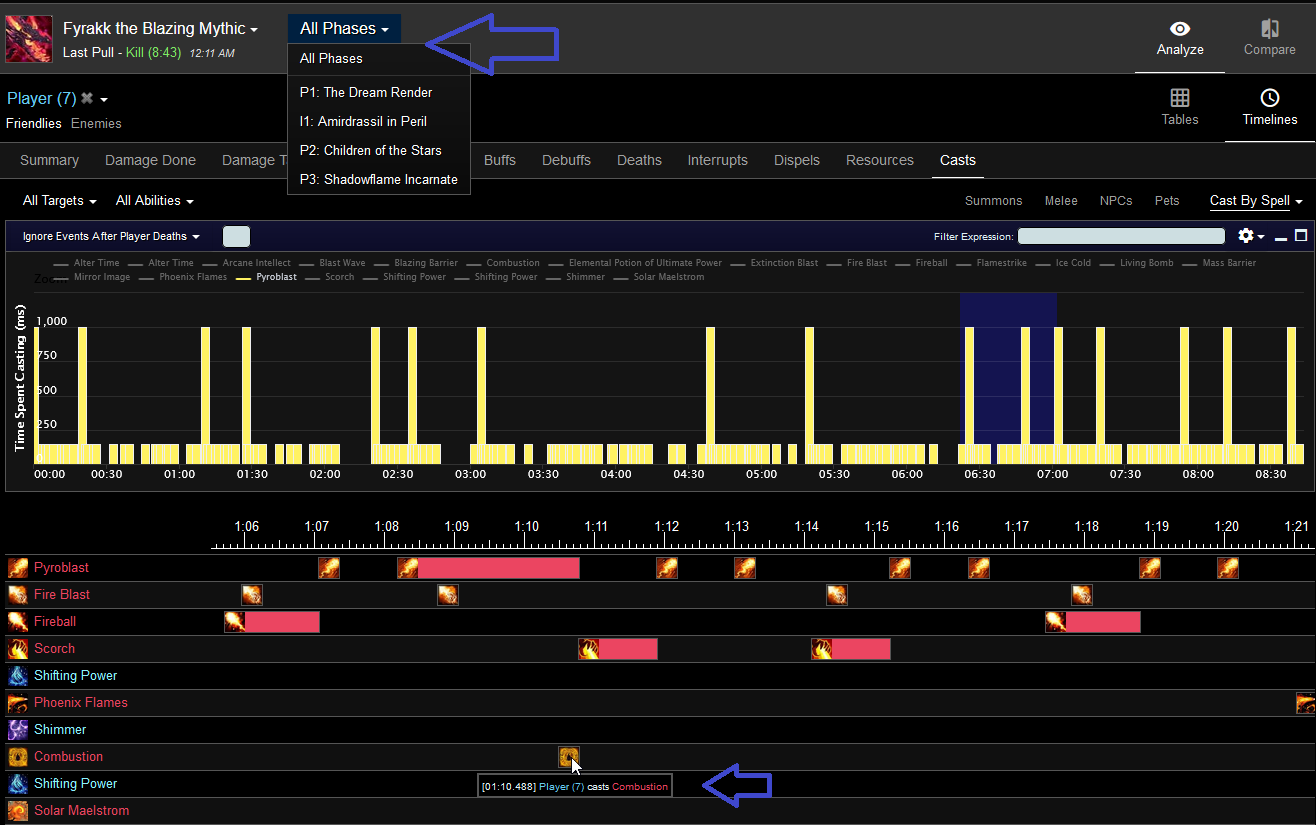 )
)
The Basics
Finding these mistakes requires a very fundamental level of Fire mage interactions. The main interactions to be concerned with are:
- Heating Up & Hot Streak. Our rotation revolves around building Heating Up with our Generators (Fire Blast, Phoenix Flames, Scorch, Fireball) and consuming them with our Spenders (Pyroblast, Flamestrike). This should always be a one-to-one trade: one Hot Streak, one spender. Any time you use a generator while you already have Hot Streak is called a munch.
- Sun King's Blessing is the focal point of our rotation. For every 8 Hot Streak consumed, we gain the buff Fury of the Sun King causing our next non-instant Pyroblast or Flamestrike to activate Combustion for 6 seconds. Any Hot Streak consumed while Fury of the Sun King is active and ready to be activated is also considered a munch.
- Combustion is our primary throughput cooldown, which for 10 seconds (12 with Improved Combustion talented), all of our Spenders and Generators are guaranteed to crit. This includes the 6 seconds granted by Sun King's Blessing. This means that anytime the Combustion buff is present, we will be chaining our Generators and Spenders in one-to-one trades.
Fire can be considered an uptime spec, with our identity revolving around constantly building and spending Hot Streak, to build and consume Sun King's Blessing, to reduce the cooldown on Combustion, to more effectively build and spend Hot Streak. It is very cyclical. Any time you 'munch', you've slowed down the cycle, pushing your next SKB & Combust just further away. This also means downtime is the enemy, and is also the most common mistakes you'll see in fire mage logs.
Fire Starter
Lusted Firestarter is the only truely scripted sequence in the fire mage rotation. In the timeline view, it should be identical to the images below. The pre-pull mirrors are optional, but a nice quality of life choice to get them on cooldown and know you have a defensive active for the duration of your lust.
With the Tier 31 tier set:
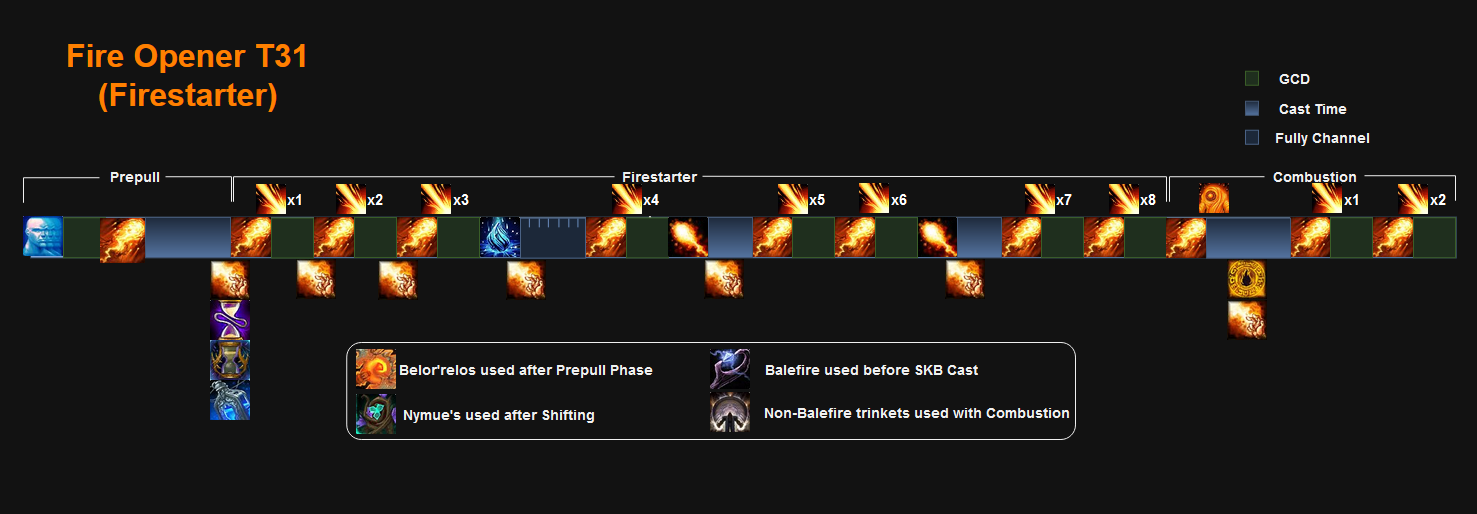
With the Tier 30 tier set:
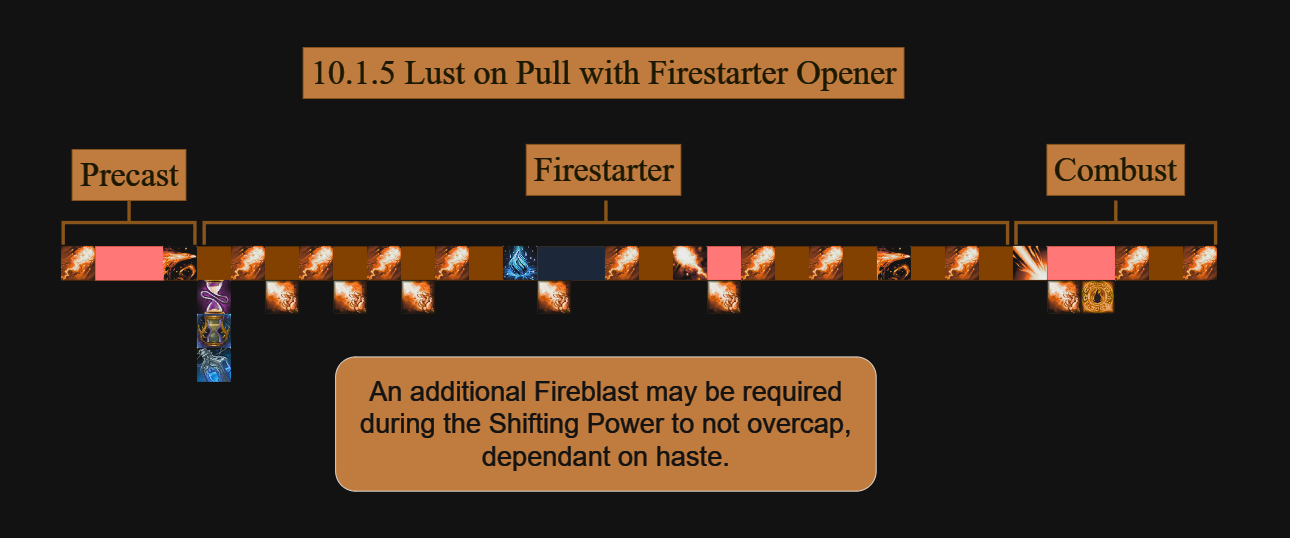
The primary difference here is the usage of Phoenix Flames. The Tier 30 bonus incentivizes us to Phoenix Flames to apply the debuff, while talenting Alexstrazas Fury means we want to press Phoenix Flames as little as possible inside of Combustion. Doing it as this image depicts fulfulls both of these requirements while efficently building a Sun King's Blessing with Firestarter
Combustion Entry
One of the most common mistake in new Fire mage logs is the Combustion entry. There are several variations of how to do this, dependant on your resources and buffs active at the time. There can be variations on these, and they simply follow two things: the priority system, and the principle of Always Be Casting- something should be on every GCD, no waiting for spells to land.
With a Heating Up active, the entry will be
- Begin a precast. This is by default Fireball with several caveats, those will be in the following sections.
- During the precast, press Fire Blast once. This converts the Heating Up to a Hot Streak.
- Before the precast ends, as close to it's finish as you can reliably be, press Combustion.
- As the precast ends, spam your spender (Pyroblast or Flamestrike). This consumes the first Hot Streak.
- Continue spamming your spender. The precast and the first spender will hit the mob, granting you a second Hot Streak.

Without a Heating Up active, the entry will be almost identical with one change.
- Begin a precast. This is by default Fireball with several caveats, those will be in the following sections.
- During the precast, press Fire Blast once. This will grant you a Heating Up.
- Before the precast ends, as close to it's finish as you can reliably be, press Combustion.
- As the precast ends, spam Scorch. Replace this with Fireball when haste is in excess of 100%.
- During the Scorch, the precast spell will land, converting the Heating Up to Hot Streak.
- As the Scorch ends, spam your spender (Pyroblast or Flamestrike). This consumes the first Hot Streak.
- Continue spamming your spender. The Scorch and the first spender will hit the mob, granting you a second Hot Streak.

The caveats where your precast changes:
- You are talented into Meteor and it is off cooldown. In this instance, the optimal cast sequence is to Meteor prior to the precast, and replace Fireball with Scorch as the precast. The remaining sequences are the same following the Heating Up and No Heating Up guidelines above. When excessively hasted (greater than 100%), you can still Fireball. The goal here is to ensure Combustion is active before Meteor impacts. Note that the hardcasted Pyroblast or Flamestrike cast is too long to effectively do this with a Sun King's Blessing combustion.
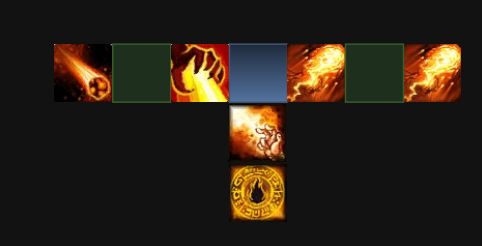
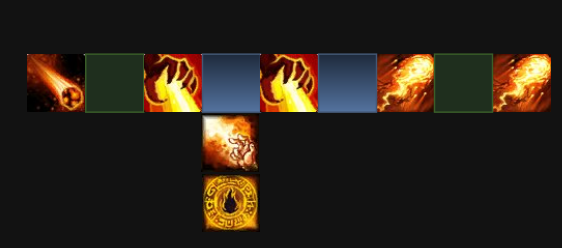
-
You have a Fury of the Sun King buff active and ready to consume by hard-casting a Pyroblast or Flamestrike. In this case, you will replace the Fireball with a Pyroblast or Flamestrike, ensuring you activate combust before the cast finishes. Sun King's Blessing extends Combustion. Combustion overwrites Sun King's Blessing. If you activate Combust before the hard cast finishes, you will be granted both- 18 seconds of Combustion. If you activate it too late, you will overwrite the Sun King's Blessing and only get 12 seconds.
-
You are talented into Improved Scorch and the target is in execute. Replace the Fireball with a Scorch to refresh the Improved Scorch debuff.
What this typically looks like in new Fire Mage logs
In a Sun King's Blessing Combustion, this mage was waiting for the precast to land.

In this example the mage made several mistakes. They have the gap of waiting for the precast to land, and they're using a Combustion + trinket/pot macro. This macro is fine to use, but you do not want to create any gaps with it. It should go on the GCD between your first two Hot Streak spenders instead. Using the macro in this fashion means you will press it twice. Once to activate Combustion, and again on the first free GCD to activate the trinket/racials. An alternative approach to this is a Pyroblast macro (this must be a dedicated bind not your standard Pyroblast key). used in the same manner.

When to use things
- Meteor is used whenever it can impact during Combustion. This can be as described in the above section, where you can use it before the Combustion cast and have it impact inside; or you will give up a global inside Combustion/skb for this to occur. Note that the SKB hardcast is too long to precast Meteor and still have it impact in the combust, so you'll use it on an early global after the hardcast.
- Sun King's Blessing is sent on proc almost every time. Exceptions for this are rare- unless you're sandbagging the end of a pack to have SKB ready for the pull of the next.
- Living Bomb can be used almost identically to metoer, activate it outside of combust or skb and have it pop inside in aoe only. Don't waste global inside combust for it. You can do this before the SKB hardcast.
Trinkets: The vast majority of them will be utilized on the first free gcd of combust. Some exceptions:
- Belor'relos is used on cooldown outside of Combustion. Combustion does not effect the damage of any items in the current rotation.
- Intellect steroid trinkets such as Ashes or Balefire Branch can be used before an SKB hardcast, if you will be activating Combustion during the hard cast. Otherwise, use it first gcd of Combustion as usual.
- Channeled trinkets like Nymue's Spindle should be used before Combustion, not inside. It's rarely the right call to send a trinket with a solo SKB. We generally do not hold Combustion for trinkets, we'll hold trinkets for combust.
Sloppy Filler and Hot Streak Fishing
One of the largest mistakes new mages make is over spending resources in filler, trying to chase the next Sun King's Blessing proc with no regard for allocating resources to spend inside of it.
In this image, the player is burning their Fireblasts and PF to chase the SKB, resulting in a lackluster SKB from resource starvation.

Our filler varies slightly depending on talent selection (and tier set in the case of T30), but the core concept of it is we want to fish with Fireball. This means, we're chain casting Fireball hoping for a Heating Up off one of them. We don't wait to see if one crit or not before casting the next, we just react if it does; converting with a Fire Blast. In the example below, the third Fireball crit giving the mage a Heating Up, they converted mid cast of the next one with Fire Blast, and consumed it at the end of the Fireball with Pyroblast. This is the correct filler.

This 'fishing' is to take advantage of what's called the 'grace period'. When two spells hit within this grace period, either or both can contribute to a Heating Up / Hot Streak. If they are not both within this grace period, and the second spell to register does not crit, it will kill your Heating Up.
Generic Downtime
Fire very much needs to always be casting something, more casting means more cooldown reduction from Kindling, which means more Combustion and SKB. Minor gaps in your dps add up very quickly. The vast majority of our abilities happen on the gcd (global cooldown) which is by default 1.5 seconds, reduced by haste. Notable exceptions to this are Counterspell and Fire Blast (which is also cast-while casting or CWC). During double lust, current geared mages will exceed 100% haste dropping their gcd to 0.75s which is the lowest the gcd can go.
In practice, this just means we want to see something happening on every gcd. Examples of this not occuring:


Munchies Munchies
In the terms of fire game play, a munch can mean two specific things. You've used a generator while a Hot Streak is already active, or you've 'munched' a Sun King's Blessing stack by consuming a Hot Streak while Fury of the Sun King is ready to be activated. The second one is the easiest to identify. Count to 8 instant Pyroblast in your log, the next should be a hard-casted one. Currently we do NOT hold Sun King's Blessing for any reason, including inside of Combust.

The other method of munching can be harder to identify, because there are just a lot of ways of doing it. A few examples of what it can look like:
The double PF is a very common mistake. its travel time makes people think they need to press it again.

An incorrect entry munch, in this instance the player spent a Fireball, Phoenix Flames, and a Fire Blast for a single HS pyro.

A harder to spot example. This player was excessively hasted and used a Fire Blast during a Scorch. With Scorch being under the GCD, they were unable to generate both Hot Streak for the double Pyroblast, meaning the Fire Blast during the Scorch was a munch.

Hardcasted Flamestrike is a special interaction that isn't very intuitive. Unlike Fireball or pyroblast, which has travel time; or Scorch which has a grace period, queueing a Hot Streak spender off of a Flamestrike (with Fuel The Fire talented) will result in a munch. What this means is we will never convert a Heating Up to a Hot Streak during a hard-casted Flamestrike. This currently only applies to activating Sun King's Blessing, as that is the only time we hard-cast Flamestrike, but it is something to be aware of (and is something that can change at any point with tuning).
Buffs and Debuffs
Fire has a handful of things we need to juggle, the most important being Sun King's Blessing, followed by Feel The Burn and Improved Scorch. When Tier 30 is equipped, we also need to add in Charred Embers.
Sun King's Blessing is easy to check.
- Select the Player
- Select the 'Buffs' Tab
- From the dropdown, navigate to 'Sun King's Blessing'. This view will allow you to see how long you sat at specific stack levels, the one we primarily care about can be seen by filtering to Fury of the Sun King instead.
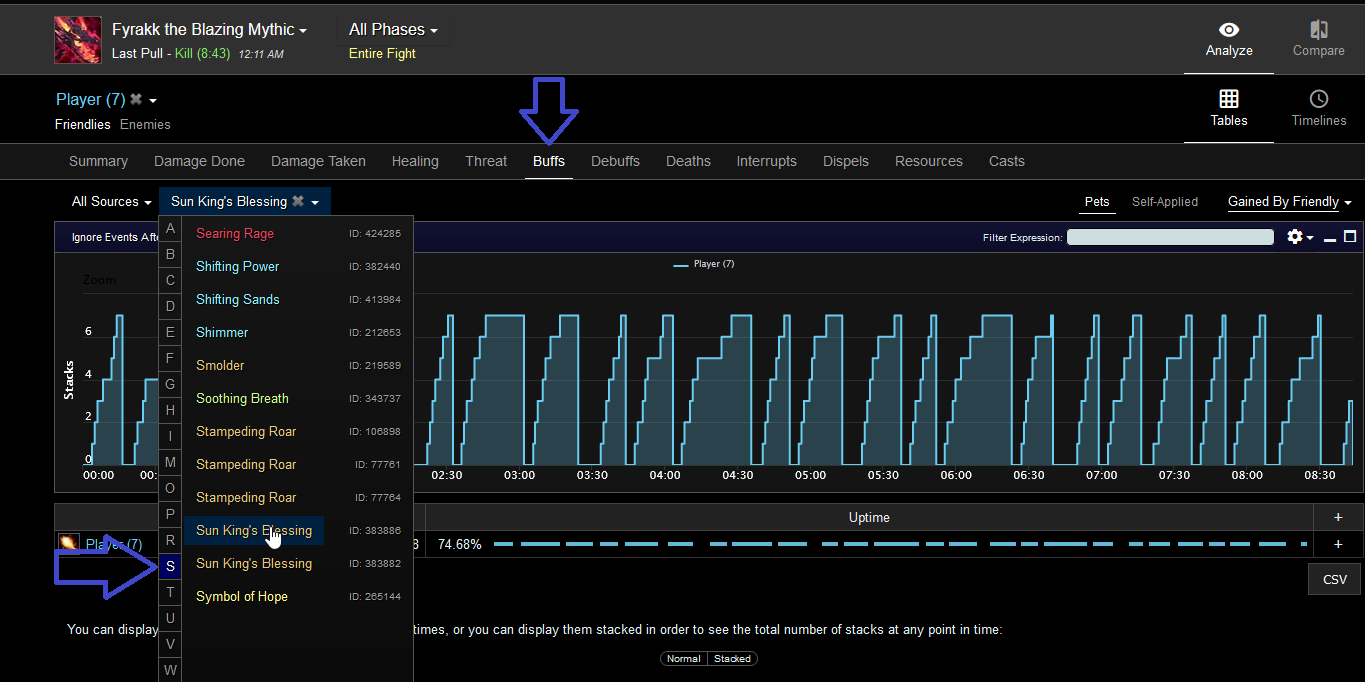
The Fury of the Sun King buff indicates we have an SKB ready to activate. We never really want to sit on this buff, seeing it's duration being active for longer than a ~5 second window is likely a mistake.
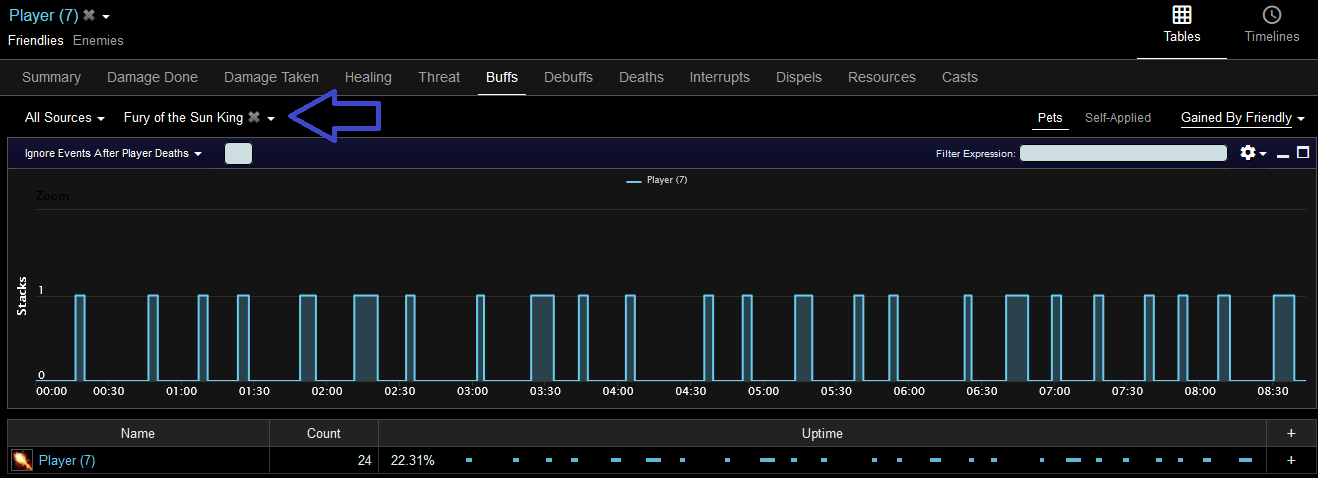
Flame Accelerant can be tracked in much the same way. Current usage means there will be times where you sit on it a little longer, as it is below the priority of maintaining buffs/debuffs such as Feel The Burn and Improved Scorch. But if you identify long periods of no usage, that is likely somewhere improvement can be made.
This log likely could have found time to utilize Flame Accelerant in the last 1:15 of the fight.

Feel The Burn is an important buff to maintain in Combustion. During filler, it will drop. Where possible, we want to chain it across a Combustion to a Sun King's Blessing Combust. In raid, your Feel The Burn should look like a set of several stair cases.
This is pretty good Feel The Burn, defined windows of where they were in Combustion or Sun King's Blessing.

This is a poor Feel The Burn. They have a mountain ridge instead of staircases.

Improved Scorch is slightly different as it is a debuff on the target.
- Select Enemies
- Debuffs
- Select the mage as the source
- and filter by Improved Scorch
This is a fairly decent Improved Scorch example. Once it's built to three, you never want it to drop off.

This is a not ideal situation, the mage allowed Improved Scorch to fall off and had to rebuild it.

For the T30 tier set, you can check the uptime of in the same manner, and the ideal uptime for this debuff is 100% on your primary target.
Movement and over Scorching.
Fire is a very mobile spec, we are almost always in chains of instant casts and have tool such as Shimmer or Ice Floes to protect our hardcasts. With that in mind, and knowing that we are an uptime spec, quiet movement is critical. While we can use Scorch to maintain our uptime, it's damage outside of execute is extremely mediocre. It is our last resort cast to cover movement, not the primary tool to do so.
Many new mages will look like this, where they are excessively spamming Scorch to move. This is bleeding damage, you need to plant and Fireball your filler.

Shifting Power
Shifting Power should always have a total of four ticks.
This is an incorrect Shifting Power. If this is a chronic issue for you, consider using a 'nochanneling' macro. This will create a small gap after your Shifting Power, but is preferable to clipping a tick.

This is a correct Shifting Power.

Using Lorrgs to adapt to raid encounters
Lorrgs.io displays the cooldown timing of the top logs. This is not always the best usage for progression, but will give you an idea of how to maximize your damage potential for the fight. Keep in mind that many of the top logs will have externals such as Power Infusion or Blessing of Autumn, which will reduce their cooldowns.
You can export the cooldown timings to an ERT note, and paste it in game in your personal note in combination with Weakauras like Kaze ERT to attempt to replicate. Remember, what works for them may not work for you, kill timings and composition matters.
